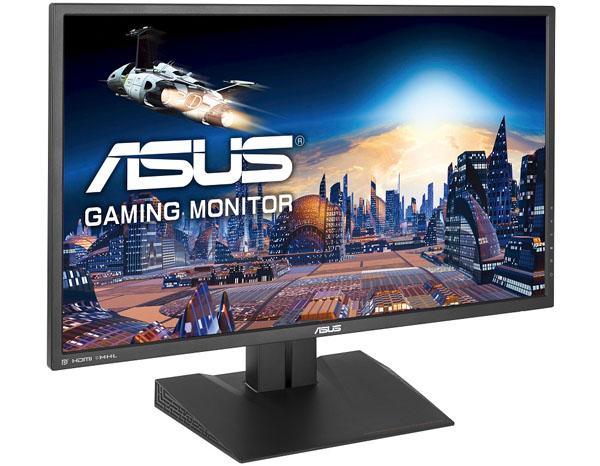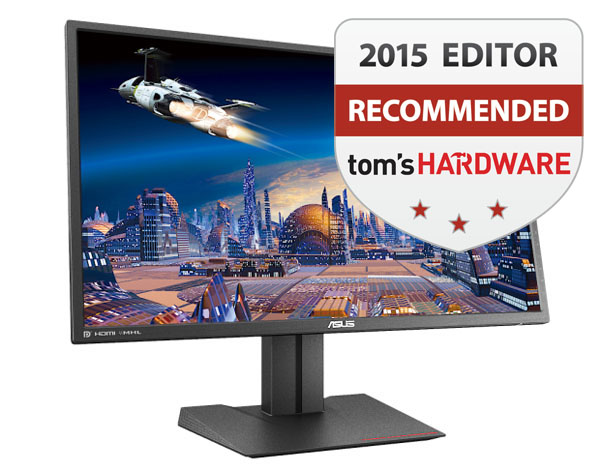Asus MG279Q 27-Inch FreeSync Monitor Review
Today we're reviewing Asus' MG279Q FreeSync gaming monitor, looking at how well it compares to Acer's XB270HU IPS G-Sync monitor?
Why you can trust Tom's Hardware
Conclusion
It's not surprising that we're very pleased with the MG279Q. Since it's very similiar to Acer's XB270HU monitor, it should perform the same with regards to contrast, color accuracy, brightness and overall image quality; and it does.
AHVA represents a new crop of IPS panels that offer better viewing angles and in this case at least, 144Hz operation. Gamers have long wished for more IPS options and even though they're still scarce, you can now choose between two excellent screens from mainstream companies. The only other deciding factor is to go with G-Sync or FreeSync.
The debate about which is better rages on and even after our G-Sync vs FreeSync Reader's Choice event last month, there are still some points to argue. The only firm conclusion we can draw at this time is that G-Sync offers a more mature technology with more consistent implementation. You know that if you buy a G-Sync display it will work at up to 144Hz and when your game drops below 30fps, its frame-doubles rather than switching to V-Sync.
FreeSync is an open spec, which means each monitor can be slightly different in its implementation. Case in point is BenQ's overdrive issue with the XL2730Z, which has since been fixed through firmware. And now the MG279Q with its 90Hz upper limit. But we're satisfied that that's not really a limit after all. Our gaming experience shows that high framerates make the difference between FreeSync and non-FreeSync play to be practically non-existent.
The biggest divide between the two technologies seems to be cost. Since FreeSync is part of the DisplayPort spec it doesn't require extra hardware or licensing. G-Sync is all Nvidia and currently adds around $200 to the price of every monitor it comes with. Now that we have two nearly identical products in the MG279Q and XB270HU, that divide is clear. At the time of this writing the Acer monitor is approximately $250 more than the Asus MG279Q.
When choosing between the two, the question to ask yourself is this: which video board are you using? If the answer is Nvidia, then what are you willing to pay for a 144Hz QHD/IPS gaming monitor?
We enjoyed using both displays and given the performance test results and actual hands-on experience, there's no clear winner in our eyes. If you make frame-rate-matching your priority, G-Sync seems to have an edge in consistency right now. But from an image quality standpoint, the MG279Q and XB270HU are equals. So if price is your guide, Asus becomes the winner.
Get Tom's Hardware's best news and in-depth reviews, straight to your inbox.
We like this new Asus gaming screen very much. For its image quality, performance and trouble-free FreeSync implementation, we're giving it the Tom's Editor Recommended Award.
MORE: Best Computer Monitors
MORE: Display Calibration 101: Step-By-Step With Datacolor's Sypder4Elite
MORE: Display Calibration 201: The Science Behind Tuning Your Monitor
MORE: All Monitor Articles
MORE: Displays on the Forums
Current page: Conclusion
Prev Page Viewing Angles, Uniformity, Response, Lag And FreeSync
Christian Eberle is a Contributing Editor for Tom's Hardware US. He's a veteran reviewer of A/V equipment, specializing in monitors. Christian began his obsession with tech when he built his first PC in 1991, a 286 running DOS 3.0 at a blazing 12MHz. In 2006, he undertook training from the Imaging Science Foundation in video calibration and testing and thus started a passion for precise imaging that persists to this day. He is also a professional musician with a degree from the New England Conservatory as a classical bassoonist which he used to good effect as a performer with the West Point Army Band from 1987 to 2013. He enjoys watching movies and listening to high-end audio in his custom-built home theater and can be seen riding trails near his home on a race-ready ICE VTX recumbent trike. Christian enjoys the endless summer in Florida where he lives with his wife and Chihuahua and plays with orchestras around the state.
-
Kridian I'll buy one when they get to the $300 mark. Come on OLED, let's push some prices down!Reply -
ceberle ReplyAny 21:9 3440x1440p G-Sync/FreeSync monitor reviews on the horizon? Thanks
I've just finished testing the Acer XR341CK. Look for the review soon!
-Christian-
-
moogleslam Reply16520347 said:Any 21:9 3440x1440p G-Sync/FreeSync monitor reviews on the horizon? Thanks
I've just finished testing the Acer XR341CK. Look for the review soon!
-Christian-
Awesome Christian - thank you! This week? :) Will you be reviewing the G-Sync version when it comes out also? It's supposedly a little different in that it will be 100Hz whereas the FreeSync is 75Hz. Thanks
-
nate1492 You tested a $600 144hz ips monitor with a $150 graphics card and you didn't push the framerates?Reply
I don't see the validity of this review, why would you use such a middle range graphics card for a high end monitor? I don't see many people shelling out $600 for monitor and $150 for a gfx card!
It almost sounds like you chose the amd 285 because you realized it couldn't push the monitor to the upper 100s FPS. -
nate1492 You tested a $600 144hz ips monitor with a $150 graphics card and you didn't push the framerates?Reply
I don't see the validity of this review, why would you use such a middle range graphics card for a high end monitor? I don't see many people shelling out $600 for monitor and $150 for a gfx card!
It almost sounds like you chose the amd 285 because you realized it couldn't push the monitor to the upper 100s FPS. -
picture_perfect Replywhy would you use such a middle range graphics card for a high end monitor?.
The results will probably be more in line with people's experience. Great review. I prefer fps over resolution so will pass on this monitor.
-
hannibal The problem in image quality is when the frame rate drops too low, so not too powerfull GPU is good for testing that. If you have GPU that can run 144 FPS all the time, it does not need G-sync of Freesync...Reply
And I personally would put any day more money to monitor than graphic card. Good monitor is so much better deal in the long run!
-
skit75 Reply16520396 said:You tested a $600 144hz ips monitor with a $150 graphics card and you didn't push the framerates?
I don't see the validity of this review, why would you use such a middle range graphics card for a high end monitor? I don't see many people shelling out $600 for monitor and $150 for a gfx card!
It almost sounds like you chose the amd 285 because you realized it couldn't push the monitor to the upper 100s FPS.
What would be the point of that? It is a QHD IPS panel with a known sync range. If you have a monster GPU, just get a 144Hz monitor and be done. You likely don't need Free-Sync or G-Sync if all your games play at 100FPS +.

